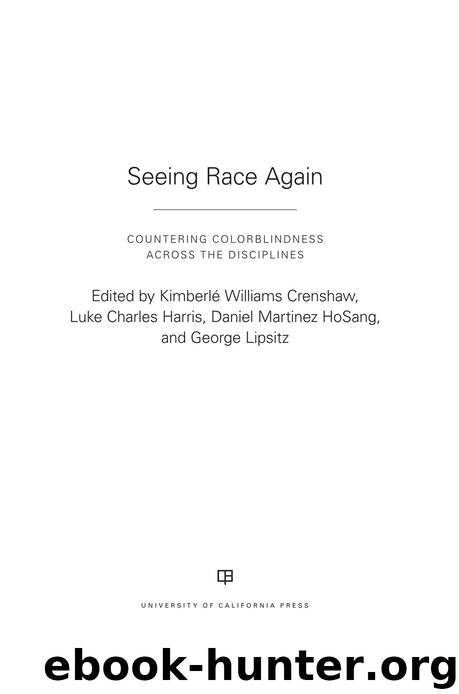Seeing Race Again by Crenshaw Kimberle;Harris Luke Charles;HoSang Daniel;Lipsitz George;

Author:Crenshaw, Kimberle;Harris, Luke Charles;HoSang, Daniel;Lipsitz, George;
Language: eng
Format: epub
ISBN: 9780520300972
Publisher: University of California Press
ESSENTIALLY FEMALE: OR FEMALE LIKE A WHITE HETEROSEXUAL WOMAN
In August 2000, Darlene Jespersen, a successful and well-liked bartender who had worked at Harrah’s Casino in Reno for over two decades, found herself out of a job. Harrah’s fired Jespersen because she refused to comply with the company’s grooming policy. Instituted in February 2000 as a part of Harrah’s Beverage Department Image Transformation Program, the policy mandated that Harrah’s female employees wear makeup. Jespersen refused to do so. Harrah’s then terminated her employment, and Jespersen responded with a sex discrimination lawsuit.12
Jespersen rested part of her legal argument on a case that was decided some twenty years earlier, Price Waterhouse v. Hopkins.13 In that case, the accounting firm Price Waterhouse denied Ann Hopkins, a white woman, partnership. The record revealed that one partner explicitly informed Hopkins that she was too “masculine,” and another told her that, to improve her chances the following year, she should “walk more femininely, talk more femininely, dress more femininely, wear make-up, have her hair styled, and wear jewelry.”14 The Court found in Hopkins’s favor based on an antistereotyping and gender nonconformity theory: employers cannot require females to be feminine and males to be masculine.
Jespersen argued that Price Waterhouse applied to her case. Her claim, in effect, was that via its grooming policy, Harrah’s Casino was asking Jespersen to “dress more feminine, wear makeup [and] have her hair styled.”15 Harrah’s was forcing her to align her sex (female) with a normative gender alignment (femininity). The court rejected this argument, and Jespersen lost her case. The Ninth Circuit, the highest court to hear the case, adopted a formal equality approach that reflected both gender normativity and colorblind intersectionality.
To appreciate the court’s formal equality approach, one has to understand the legal doctrine the court employed to adjudicate the case: the “equal burdens” framework. Under this framework, a company’s grooming policy constitutes sex discrimination if it burdens one sex more than the other. The court’s application of this standard was overly formalistic. In concluding that Harrah’s grooming policy equally burdened men and women, the court reasoned that the policy regulated men’s and women’s hairstyles, men’s and women’s clothing, men’s and women’s shoes, men’s and women’s fingernails, and men’s and women’s faces. This formal equality approach obscured the fact that the grooming policy was quite literally producing normative masculinity and femininity and instantiating impermissible sex stereotyping. The policy ensured that men looked and acted like men (masculine) and women looked and acted like women (feminine). Women must wear makeup (“face powder, blush, and mascara” and “lip color must be worn at all times”). Men are prohibited from doing so. Women may wear colored nail polish. “No colored polish is allowed” for men. Men are not permitted to have ponytails. Women’s hair must be “teased, curled, or styled.” Men’s hair “must not extend below top of shirt collar.”16
The foregoing differential grooming standards align with our normative assumptions about how men and women should make themselves up. Conventionally, we expect women to wear makeup, not men.
Download
This site does not store any files on its server. We only index and link to content provided by other sites. Please contact the content providers to delete copyright contents if any and email us, we'll remove relevant links or contents immediately.
| General | Discrimination & Racism |
Nudge - Improving Decisions about Health, Wealth, and Happiness by Thaler Sunstein(7190)
iGen by Jean M. Twenge(5125)
The Fire Next Time by James Baldwin(4985)
Adulting by Kelly Williams Brown(4197)
The Hacking of the American Mind by Robert H. Lustig(4051)
The Sports Rules Book by Human Kinetics(4042)
The Ethical Slut by Janet W. Hardy(4006)
Captivate by Vanessa Van Edwards(3698)
Mummy Knew by Lisa James(3495)
In a Sunburned Country by Bill Bryson(3331)
The Worm at the Core by Sheldon Solomon(3293)
Ants Among Elephants by Sujatha Gidla(3260)
Suicide: A Study in Sociology by Emile Durkheim(2885)
The Slow Fix: Solve Problems, Work Smarter, and Live Better In a World Addicted to Speed by Carl Honore(2818)
The 48 laws of power by Robert Greene & Joost Elffers(2739)
Humans of New York by Brandon Stanton(2661)
Handbook of Forensic Sociology and Psychology by Stephen J. Morewitz & Mark L. Goldstein(2588)
The Happy Hooker by Xaviera Hollander(2558)
The Tipping Point by Malcolm Gladwell(2527)
